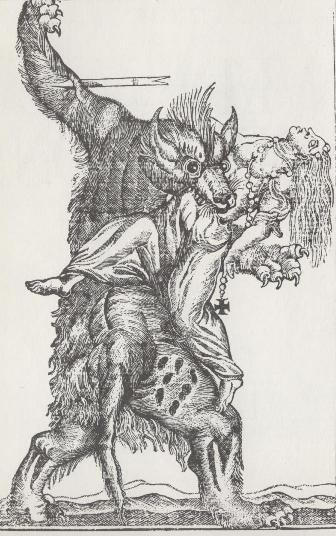There seems to be a real interest, this haunting season, for cultures to claim their monsters. I recently wrote about a story on the Jewish background to Frankenstein. I also saw an article in Greek Reporter titled “The Ancient Greek Origin of Werewolves,” by Tanika Koosmen. Earlier this year I read a book about the werewolf in the ancient world. Unlike Frankenstein, or even Dracula, the werewolf has no defining novel. Perhaps one of the reasons is that human-animal transformation stories have been around a very long time and have been extremely common. Since monsters are finally becoming a (somewhat) respectable area of academic study, and since the standard role of the werewolf is well established, it’s too late for anyone to write the defining novel now.
As the article, as well as many books, point(s) out, Lycaon was transformed to a wolf by Zeus as punishment. The ancient Greeks liked stories of such transmutations, as the work of Ovid clearly shows. Although these aren’t monsters in the Greek way of thinking—they had plenty of monsters—there is a real wonder in the ability to transform. Becoming something else. People have long found the idea compelling. Almost religious. Animals, although closely related, have incredible abilities we crave for ourselves. The werewolf, of course, represent the freedom of the beast. Outside society it lets the pent up violence and frustration out through attacking others. It’s very primal. And so very human.

Not Nabonidus, but maybe one of his kids?
" data-orig-size="336,536" data-image-title="Loup-garou" data-orig-file="https://sawiggins.files.wordpress.com/2009/07/loup-garou.jpg" data-image-description="Medieval woodcut of a werewolf
" data-image-meta="{"aperture":"0","credit":"","camera":"","caption":"","created_timestamp":"0","copyright":"","focal_length":"0","iso":"0","shutter_speed":"0","title":""}" data-medium-file="https://sawiggins.files.wordpress.com/2009/07/loup-garou.jpg?w=188" data-permalink="https://steveawiggins.com/2009/07/17/in-the-light-of-the-moon-sin/loup-garou/#main" alt="" class="wp-image-51" data-large-file="https://sawiggins.files.wordpress.com/2009/07/loup-garou.jpg?w=336" />What makes most monsters monstrous is their occluded humanity. They’re scary sometimes because we wonder what they’re thinking. Are they thinking of us as humans or as prey? Do they intend us harm or are they innocently trying to communicate with us? Are they evil or just misunderstood? Werewolves, for all of their violence, don’t seem to have been evil in antiquity. By the late Middle Ages into early modernity, however, they’ve been associated with the Devil rather than with the gods. People who’ve purposely decided to transform, via a pact with evil, are a different class of monster. Like the concept of witches at the same time period, Christianity demonized them by making them associates of Satan. Part of the problem is that werewolves have no origin story that we can point to, no myth that says “here’s what they really are.” As Koosmen’s article points out, transformations go back much further in history, to ancient Mesopotamia. The beast, it seems, has always been with us.
